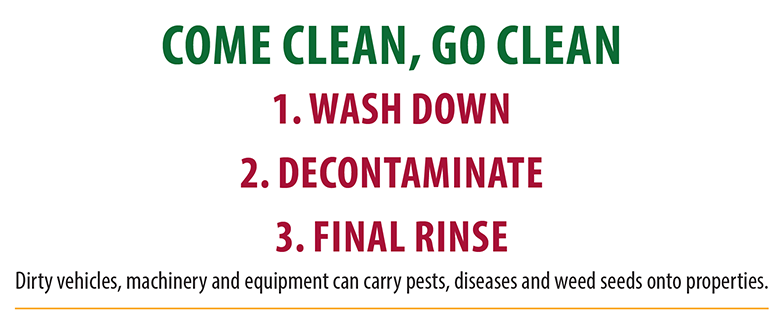A guide for agronomists
The risk of spreading diseases, weed seeds and pests within and between properties should be an everyday consideration for agronomists and consultants dealing with all grain crops, including pulses.
Clothing, footwear, vehicles and equipment can easily transport pathogens and weed seeds, as well as invertebrate pests, potentially resulting in an unwanted introduction to a farm or region and the subsequent management costs.
Disease movement
The 2016 outbreak of lupin anthracnose in southern NSW is a reminder for all how easily a devastating disease can spread via movement of people, machinery and vehicles, contaminated seed and wildlife.
While lupin anthracnose is not as easily spread as wind-borne diseases, the simple act of walking or riding a quad bike through the crop and not cleaning clothes, boots and machinery before entering another paddock can have disastrous results.
Ascochyta blight and bacterial blight are good examples of economically significant diseases that are readily spread through routine crop monitoring activities, often creating distinct patterns of infection in the crop, tracing the movement of people and vehicles.
Protecting clients' crops and businesses
Protecting clients’ crops is core business for agronomists. Following basic farm hygiene practices reduces the risk of clients incurring additional and long term management costs.
Being time poor and a lack of facilities are the most common reasons given when discussing the farm biosecurity measures that agronomists implement.
Use a practical risk assessment approach when deciding the level of hygiene required. For example if conditions are wet, weed seeds and soil-borne pathogens are easily transported in mud clinging to boots, clothing and machinery.

Top biosecurity tips
Practice Come clean Go clean
Clean down vehicles and footwear before entering and leaving a property in order to reduce the risk of introducing or moving a pest. Consultant businesses should consider purchasing transportable high pressure washers and spray tanks.
Carry a vehicle biosecurity kit
Protect clothing against contamination and clean hands, footwear and small equipment. Anyone walking into crops should consider wearing disposable coveralls and changing them between each crop or farm. Disposable coveralls are readily available at hardware stores and are inexpensive.
Keep a record of all farm visits
Keep a record of the paddocks inspected and the biosecurity practices followed during the visit to assist in the investigation of any future pest outbreak.
Discuss biosecurity with your clients
Ask clients if they have specific concerns and if they have particular requirements for farm visits and paddock inspections.
Develop a business biosecurity plan
Private and commercial agronomists should consider developing a biosecurity plan for their business. A biosecurity plan defines measures the business will implement to reduce the risk of spreading pests, diseases and weeds. It should be a simple and accessible document designed to prompt discussion with clients and set some expectations for employees.
Businesses with multiple agronomists should include a biosecurity plan in staff inductions and aim for a gradual practice change by setting an example for trainee agronomists to establish good biosecurity practice.
Investigate unusual pests and diseases, and unexplained crop death
Any unusual pests or disease symptoms, or unexplained crop death should always be investigated. Report incidents to your state agricultural department (e.g. NSW Department of Primary Industries) or call the Exotic Plant Pest Hotline (1800 084 881).
Timely reporting is important to restrict spread and provide the best chance of control or eradication. All industry stakeholders have a legal and moral obligation to report any suspect exotic pest or disease.
Vehicle biosecurity kit
Contents may include:
- dust pan and brush
- stiff brush
- hand sanitiser
- disinfectant solution, e.g. bleach
- spray bottle
- paper towel
- spare shoes
- disposable coveralls
- disposable boot covers
- disposable gloves
- plastic bags for contaminated items
- sample bags and vials
Vehicle and equipment decontamination
Agronomists who use their work vehicles when inspecting paddocks need to make time to remove any soil or plant material that may spread pests, diseases and weed seeds.
Quad bikes transported on ute trays or trailers between farms and used to inspect paddocks pose a high biosecurity risk for transporting contaminated material. These vehicles should ideally be washed down between farms, especially in higher risk conditions and scenarios.
Access to a state of the art wash bay facility to clean a vehicle is not essential; most growers will have an area used for preparing spray tanks and washing machinery that would be suitable for washing down quad bikes and other work vehicles. Alternatively, use the client’s vehicle to conduct paddock inspections and leave other vehicles at the property entrance or house.
Agronomist checklist
This is an example of a template can be used as a starting tool in the development of a biosecurity plan to assess current practices and to provide short and long term goals for practice change.
Agronomist's Biosecurity Best Practice checklist template
Biosecurity legislation
- Biosecurity Act 2015 (Federal)
- Biosecurity Act 2014 (Queensland)
- Biosecurity and Agriculture Management Act 2007 (Western Australia)
- Biosecurity Act 2015 (NSW)
- Plant Biosecurity Act 2010 (Victoria)
- South Australia Biosecurity Policy 2013–2016
- Northern Territory Biosecurity Strategy 2016–2026
Resources
Browse the excellent resources on the Farm Biosecurity website, such as these videos about managing people and machinery movements on farm:

